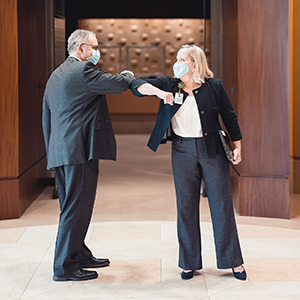New guidelines give specific tools to providers to help prioritize patient safety

To further support providers in their continuous efforts to improve patient safety, the Institute of Healthcare Improvement (IHI) released a new national patient safety action plan in September 2020.
The IHI’s “Safer Together: A National Action Plan to Advance Patient Safety,” distills into four focal points and 17 recommendations the evidence-based best practices that healthcare providers have followed since the landmark patient safety report, “To Err Is Human: Building a Safer Health System,” was released two decades ago. The report’s creators—the IHI’s National Steering Committee for Patient Safety—say these recommendations are essential for creating “total systems safety.” HealthTrust member facilities are seeing the importance of these recommendations in action.
The value of specifics & governance
While there aren’t surprises among these recommendations, the value is in the specifics, says HealthTrust Physician Advisor David Stepansky, M.D., Vice President for Quality at Community Health Systems (CHS). The action plan and its accompanying self-assessment tool and implementation guide provide concrete ways for health systems to improve.
“Everybody knows these are important things to do,” he says. “But the IHI recommendations get more specific within each of those areas as to how to do it better.”

RWJBarnabas Health’s Senior Vice President of Quality and Patient Safety, Deborah Larkin-Carney, MBA, BSN, RN, CPPS, agrees. “I think this hits the heart,” she says. “IHI did a really good job. The hospitals can take this and do something with it.”
The self-assessment tool will help healthcare providers decide when and how to prioritize safety measures. “The self-assessment tool has delineated scoring, so you know where you are and where you need to be,” Larkin-Carney explains. The IHI also provides an associated resource guide that offers specific tactics for implementing the plan’s recommendations.
A family matter
One IHI recommendation is to actively engage patients and their families and care partners in patient care and safety planning. But it’s one that may face some resistance, notes Dr. Stepansky.
For example, many physicians are not used to or comfortable with getting input from patients or their families, he says, and hospital leadership may have concerns about operational and legal issues with doing so. But this input can provide a valuable perspective on what’s going on directly with the patient’s health and their experiences during care.
“It doesn’t mean that patients and their families have to be medical experts, but they have major things they can contribute in terms of promoting safety and good communication,” Dr. Stepansky says.
The IHI action plan also advocates for including patients and their families in the healthcare facility’s patient safety infrastructure. CHS began doing so over a year ago, explains Dr. Stepansky, when each of its 89 hospitals in 16 states established a patient family advisory council (PFAC). “Everyone agreed that involving patients and families is critically important,” he says.

One successful patient and family engagement protocol the health system has implemented is the bedside shift report with a patient safety assessment. During this time, patients, their families and caregivers are encouraged to participate, says Terrie Van Buren, BSN, Vice President and Patient Safety Officer at CHS. At these bedside-shift hand-offs, the outgoing and incoming nurses go over with the patient and family or caregiver what happened during the last shift and what the expected plan of care is for the rest of the day or evening. They also discuss any special precautions that need to be taken to keep the patient safe from healthcare-acquired conditions, such as pressure injuries, falls, blood clots and infections.
It’s a practice that has helped to reduce healthcare-acquired conditions, Van Buren points out. She notes that these patient safety assessments at shift change have been instrumental in the health system’s ability to maintain an 85% Serious Safety Event Reduction (SSER) rate. “Engaging patients and family in safety has been key,” she says.

Safe surroundings
The IHI’s emphasized focus on workforce safety is also notable, Dr. Stepansky adds. “The same principles that are useful in keeping patients safe are often the same principles that keep your workforce safe,” he shares. “Plus, having a safe, healthy and happy workforce enjoying their work is very important in terms of them being able to provide good care.”
Some of the workforce safety initiatives CHS-affiliated hospitals have instituted are:
- Hospitals hold a daily huddle to discuss patient and workforce safety-related issues/occurrences and lessons learned. “These safety huddles are ‘hard-wired’ within our hospitals,” Dr. Stepansky says. As an example, some hospitals practice “Worker Safety Wednesday,” where issues impacting workforce safety are discussed among all leaders in the Daily Safety Huddle on Wednesdays.
- Designated employees are trained to lift patients properly and supplied with lifting devices to prevent injury.
- Designated employees are trained in de-escalating difficult circumstances that could otherwise lead to violence.
“We believe these activities have resulted in fewer employee injuries,” adds Dr. Stepansky.
Larkin-Carney is pleased to see that psychological safety is included in the IHI’s action plan because she considers it an important part of workforce safety.
RWJBarnabas Health locations use tactics similar to the IHI’s Root Cause Analyses and Actions (sometimes referred to as RCA squared) to understand how and why medical errors occur. Leadership has taken that process to the next level by creating a culture of psychological safety to encourage people to talk about what happens when things do not go as planned. They offer the opportunity for caregivers to gather in safe spaces to talk about tough things that come up and to provide emotional support. “We started this two years ago, and it’s been extremely popular,” Larkin-Carney says.
The four focal points and recommendations of IHI’s “Safer Together: A National Action Plan to Advance Patient Safety” are:
- Culture, Leadership & Governance
- Patient & Family Engagement
- Workforce Safety
- Learning Systems
Read more about the IHI’s four focal points and 13 recommendations.
Continuous learning
IHI’s action plan also focuses on learning systems, in which Larkin-Carney is also a big believer. RWJBarnabas Health has instituted a number of learning systems, including biweekly meetings to analyze events, daily huddles that serve as more immediate check-ins, and annual forums where various locations within the health system can share their best practices.
Dr. Stepansky is particularly interested in the possibilities of interorganizational sharing and is curious to see how that develops as healthcare systems digest and implement the action plan in the coming months. “Currently, one healthcare organization might informally share information with other healthcare systems at a conference. But the IHI suggests more formal lines of communication, recommending that organizations engage with established local, regional, state and national learning systems,” explains Dr. Stepansky. “For example, a local or state medical society or national hospital association might sponsor summits for the purpose of organizations collaborating on how to improve patient safety and quality of care.”
Larkin-Carney, Van Buren and Dr. Stepansky all agree there’s a lot to digest. Implementing the national action plan “is not something that you do in six months,” Larkin-Carney stresses. That’s where the self-assessment tool that accompanies the action plan comes in.
The intensity of IHI’s national action plan may be overwhelming for some healthcare providers, but it is doable for everyone, explains Larkin-Carney. What is required for success, though, is leadership commitment. “Leadership has to want it and believe in it,” she says. “You could put certain parts in place and start making inroads—but to do this plan effectively, you really need that buy-in.”
Dr. Stepansky notes it’s vital to keep the end goal in mind. “At the end of the day, this is about taking good care of patients,” he says. “I believe it is the calling of all those who work in healthcare to provide safe, high-quality care to the people who entrust us with their health. The IHI recommendations contribute significantly to that goal.”
Share Email Patient Experience, Q1 2021




